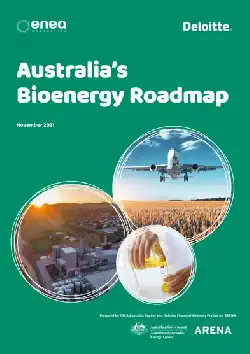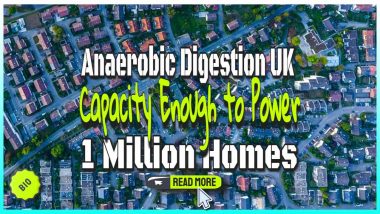The development of anaerobic digestion in Australia, after a slow start, does now seem to be picking up momentum. The process is well-known for its renewable energy production. It is less known that the biogas sector provides an alternate waste treatment method while also helping to boost local economies, but Australians are waking up to the potential.
Enea Consulting has published a public paper on bioenergy in Australia to develop which highlights the potential. The paper explores the benefits of biogas as well as the challenges that the sector is now facing in Australia.
Australia, with its hot climate, love of barbeques, and keen gardeners, is also rapidly becoming a world hot-spot for home biogas plants which are powered sustainably by the biogas from their small anaerobic digestion plants. One brand that is popular is HomeBiogas™, for example.
Anaerobic Digestion and Biogas in Australia
The benefits of biogas are evident in an age of serious climate change and imminent fossil energy collapse. It is a renewable energy source with zero net greenhouse emissions, and anaerobic digestion facilities may achieve carbon negative operations with a few weeks.
Despite this, its potential remains largely unexplored, at least in the industrialised world. Based on our study and expertise, we believe that producing renewable energy from the anaerobic digestion (AD) process, which produces biogas (which is mainly methane), is a very promising technology.
A technology that has been under our noses for so long, and now is about to see massive development. In fact, we believe it has the potential to spark an agricultural, waste management, and household green energy revolution if Australians allow it.
Australia has a significant potential for anaerobic digestion that has mainly gone unexplored until recently. Waste management, climate change programmes, and renewable energy objectives are propelling biogas technology uptake in Australia.
The continent's biogas sector has currently been in a state of flux this last few years, with an estimated 242 digesters in operation as of December 2016. The vast majority of these plants were at landfill and wastewater treatment facilities.
 The agricultural facilities mostly digest pig, cow, and poultry dung, whilst a handful of industrial digesters process and transform red meat waste.
The agricultural facilities mostly digest pig, cow, and poultry dung, whilst a handful of industrial digesters process and transform red meat waste.
Until recently the larger AD plants were all set up to generate electricity. However, that's all set to change now with Australia following the global preference to upgrade their biogas plant output.
The digester gas output is being given an additional stage known as “upgrading” and the renewable gas produced is known as biomethane. It's made from the biogas by purifying it so the cleaned-up methane becomes a pure natural gas equivalent (CNG).
Renewable CNG is the result after compressing the purified biogas. This is a high-value product that is injected into the gas mains. Maybe a little propane gas is also added to give the biomethane the same calorific value as natural gas.
‘Australia’s first’ Biomethane-to-Gas Project Launched
The Australian Government and the New South Wales (NSW) government have launched what is claimed to be ‘Australia's first’ biomethane-to-gas project. Wastewater from Sydney's Malabar treatment plant, which is considered to be Australia's largest, will be used to generate biomethane to power thousands of NSW homes and businesses.
On behalf of the Australian government, the Australian Renewable Energy Agency (Arena) has announced $5. 9 million in funding to Jemena to trial injecting biomethane into the natural gas network in New South Wales.
In a joint initiative with Sydney Water, the demonstration-scale project will upgrade biogas produced from the anaerobic digestion process at Sydney Water's Malabar wastewater treatment plant to biomethane for injection into the Jemena gas distribution network, as a sustainable low carbon emissions replacement for natural gas.
1 MW Biogas Plants in Australia
In Australia, a 1 MW biogas facility will be operational shortly. Clarke Energy is now a proud member of Bioenergy Australia, a forward-thinking organisation dedicated to hastening Australia's energy transition to bio-based fuel, gas, heat, and electricity.
As Clarke Energy continues to develop and provide factory-built, ‘plug and play' biogas products, the relationship represents the appropriate alignment of capabilities and capacity. This is being done all around Australia and New Zealand, most recently at Sydney Water's Malabar wastewater treatment plant.
Could what we flush down the toilet be used to power our homes?
Anaerobic Digestion in Australia – Sydney
After an announcement this week that gas from Sydney's Malabar Wastewater Plant will be used to power up to 24,000 households, biomethane technology is no longer on the backburner in Australia. Biomethane, often known as renewable natural gas, is created when microorganisms decompose organic material such as human waste. The demonstration project is Australia's first of its type. However, many others may soon follow. The gas pipes in New South Wales are apparently near to more than 30,000 TeraJoules (TJs) of potential biogas, enough to power 1. 4 million households.
The system is classified as a Purepac grand in Bright's modular biogas upgrading systems series, with an inflow capacity of 1,100 nm3/hr. The biogas upgrading facility will convert raw biogas from the anaerobic digestion of sludges at Sydney's wastewater treatment plant, which is the biggest in Australia.
The ultimate product is biomethane. It's a renewable gas that meets the utility's natural gas specifications and will be provided to thousands of Sydney homes and businesses via Jemena's gas network for cooking, heating, and hot water. More projects are anticipated to follow (for more information on this grant, see below).
Anaerobic Digestion in Australia – Melbourne
In 2018, it was reported that a waste-to-energy biogas plant with a capacity of 1 MW will be built in a Melbourne neighbourhood. Weltec Biopower and Aquatec Maxcon, both German biogas experts, would be in charge of the plant's construction, which was expected to take 14 months.
After a two-year planning period, building work began in October 2015. The energy generated by anaerobic digestion of organic waste will be utilised to power the sewage and recycled water treatment plants of Yarra Valley Water, one of Australia's leading water supply and sewerage service businesses. The firm will become energy self-sufficient at its Aurora facility, thanks to two new 530 kW engines, and will even send excess electricity back into the grid.
Anaerobic Digestion in Australia – Perth
Biogas Renewables, located in Perth, has completed construction of a facility capable of processing between 35,000 and 50,000 tonnes of food waste per year and producing between 2. 4 and 2. 6 megawatts of electricity.
The initiative earned the firm the “Large scale bioenergy innovation award”, with Bioenergy Australia CEO Shahana McKenzie stating that the application of anaerobic digestion to food waste is a significant breakthrough for the Australian industry.
Bioenergy Companies in Australia
Delorean Energy, Biogass Renewables, Cleantech Energy, and Tekpro merged to form the Delorean Corporation in 2019.
Delorean Energy is a corporation that develops and manages infrastructure. In Australia and New Zealand, Tekpro is a fabrication contractor, while Biogass develops and builds bioenergy plants. Meanwhile, Cleantech was formed to hold retail licences in both the wholesale and national power markets in Australia.
Australian bioenergy firms are planning and constructing biogas facilities to put the world's garbage to use. Every day, they work hard to convert the garbage into a useful resource.
They are dedicated to offering clients solutions that are practical, attainable, and nimble. Their work is based on a thorough grasp of the anaerobic digestion process and is supported by rigorous engineering.
The most experienced biogas engineering firms in Australia provide projects for clients ranging from small to big industrial facilities such as food producers, wastewater treatment authorities, energy corporations, and agricultural clients.
Can Australia Catch Up with the Anaerobic Digestion World Beaters?
The challenge is there. Can Australia ever catch up with the anaerobic digestion world beaters?
Germany is a worldwide powerhouse. It has over 12,000 bioenergy units and has been upgrading and decarbonizing biogas for injection into the gas grid for around 30 years. Each week, one new biomethane plant is linked to the gas network in France. According to Waterhouse, one of Australia's main challenges for biogas is unfavourable legislative conditions, particularly when it comes to injecting biogas into the grid.
Not all anaerobic digestion feedstocks can be easily converted into biogas. The chicken business in Victoria, Australia, generates around 450,000 tonnes of waste each year. This garbage has a high methane potential and might be utilised to fuel biogas facilities that generate power and heat. At the same time, the issue of high quantities of protein and amino acids impeding anaerobic digestion has been resolved in a considerable number of German and UK AD facilities.
Malabar Wastewater Treatment AD Plant Biogas Upgrading Facility Awarded in Australia
At Sydney's Malabar Wastewater Treatment Plant, a new biomethane upgrade plant will convert raw biogas into biomethane, which will be accessible to consumers through the current grid network by 2022 for use in cooking, heating, and hot water. The NSW Government, energy infrastructure provider Jemena, the Australian Renewable Energy Agency, Energy Networks Australia, and the Greenpower Accreditation Initiative are all jointly responsible for the programme.
Bright Biomethane has collaborated with the Australian firm Eneraque to construct the biogas upgrading facility. Bright will build its first biogas upgrader in Australia with this project.
Biogas derived from Sydney water will be processed and distributed via the grid. The Malabar biomethane project, which is billed as Australia's first biomethane gas grid injection project, is set to be finished in 2022.
Home Biogas Plants in Australia
A well-functioning biogas plant does not have to be enormous to give considerable environmental and economical benefits to your house or company.
With its beautiful terrain and plenty of sunshine, it's no surprise that Australia has a vibrant environmental movement. This, along with a strong desire to live independently of large energy firms imposing escalating rates, as well as the growth of the renewable energy industry, has prompted an increasing number of Australians to embrace life “off the grid.”
According to the Energy Supply Association of Australia, Australia has the highest rate of home solar panel installations in the world. Home biogas plant use is growing rapidly. Perhaps it will soon be able to claim the distinction of one of the countries with the highest home biogas unit utilisation rates in the world!
Home biogas appliances might be extremely beneficial to Australian homes, who, according to the Australian EPA, squander one out of every five shopping bags of goods purchased.
Every year, one out of every five shopping bags results in a $3,800 loss of groceries per home. A home biogas system may save those would-be goods while also generating monetary value in the form of free cooking gas.
Many of Australia's home biogas plants are managed by households that live off-the-grid and attempt to live independently. Their goal is to be disconnected from municipal water, sewage, gas, electricity, and other mass utility infrastructure.
The movement is gaining traction, but each person and family has their own motivations for taking the plunge. Some make the switch to decrease their ecological imprint or be closer to nature, while others do it for cost-effectiveness or the desire to become totally self-sufficient. The consumers of home biogas plants, like the reasons for adopting this lifestyle shift, are often distinct and different.
A basic residential biogas plant with no pumps or other moving components is a fantastic option for these folks to produce their own cooking gas and fertiliser for their gardens and the crops produced on their homesteads.
Why Want all the Latest in Biogas?
So, why should you want the latest technology in biogas? The reason is that although biowaste energy and biogas are at this time only a minor component of Australia's renewable energy transition, they have enormous potential.
Biogas is one of the country's lowest sources of clean energy, accounting for barely 5% of the renewable energy profile, according to the current Clean Energy Council 2021 clean energy report. That indicates there are easy profits to be had in this market!
There are several advantages to anaerobic digestion. When compared to standard manure management practices, running a biogas plant on a farm may significantly reduce pollution and agricultural emissions.
So, we recommend that to get started those that have an interest in this should seek out training in the design and technology of AD systems.
The components of a biogas and digestate recovery system are described in the “Handbook for Agstar Project Development”. Read this and find out about the most recent industry knowledge and best practices for AD and biogas systems. It includes information about various applications and processes, advantages, problems, feedstocks, products, economic and financial aspects, and much more.
Conclusion – Anaerobic Digestion in Australia
Australia's connection with organic waste has improved as a result of biogas technology. Human and animal excreta, plant leftovers, and food-processing waste are all changing. They are converting biowaste into a commercial renewable energy source as well as a source of cooking gas for their homes and barbeques.
According to recent research, Australia generates over 20 million tonnes of organic waste each year from home and industrial sources. As a result, a considerable share of national greenhouse gas emissions is attributed to this. Manure from animal sectors alone contributes to 22 million tonnes of CO2. It can help massively to reduce these greenhouse gas emissions.
What could be better than to use this resource for its many benefits to the biogas plant operators while also helping the national and global fight to avoid runaway climate change?








